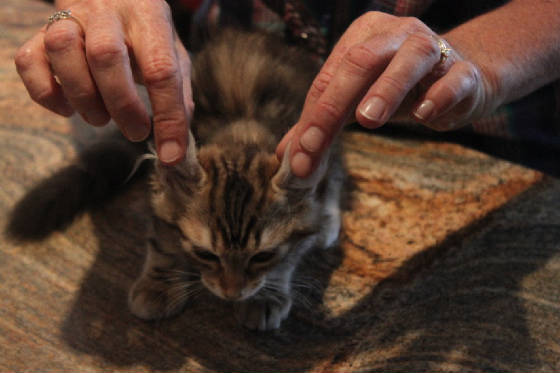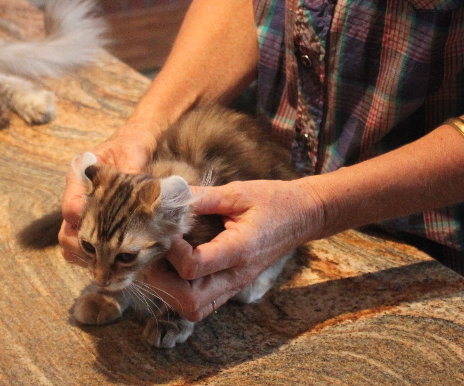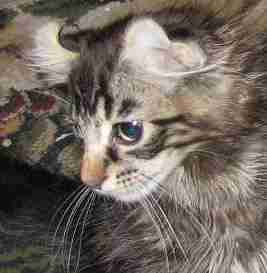|
In the photo below, pay particular attention to where Grace's fingers are. She is GENTLY feeling the cartilage
in the ear for crimps and thickness of cartilage. You can see some crimps, some of them are only detected by feeling
for them. (Crimps are passed from generation to generation. Unless the cat you are breeding has other really great
features, don't breed cats with vertical or horizontal crimps. If you do breed a cat that has a crimp, don't, DON'T,
D-O-N-'T breed cats with a history of crimps on both sides of your pedigree. This is not a trait you want "set" in your
breeding program.)
You will rarely see judges handling the ears of your cats, It's probably best if they don't know how without hurting
them. You do not need to dig your fingers into the base of the ear to feel for crimps, but you may have to GENTLY place
your index finger inside the curvature of the ear with your thumb on the outside of the ear and GENTLY
and SMOOTHLY draw your fingers from the base to the tip of the ears. If you GENTLY squeeze your two fingers as you draw
them to the length of the ear, you will feel any bumps or ridges in the cartilage. You will also be feeling for thickness
of the cartilage. (Note that you are FEELING the cartilage, not SQUEEZING it.)
This is really hard to describe in words. It's best illustrated in a video. We'll be adding a few videos
in the future. To help people that don't have computers or internet service that can open larger files, we will keep
the videos to a minimum.

If you are gentle but firm and controlled when you handle your cat's head and ears,
they won't fight you and this type of handling will not become a negative experience for them. ... they key words here are
"GENTLE" & "CONTROLLED". Until you know you can handle your cat's ears without any trauma to the cat, just take
it slow. If they wiggle or squirm, let them. Pick them up, cuddle a little with them and try again. Sometimes,
it may help to have one person hold the cat and take a photo and then evaluate the photo. Until you acquire a trained
eye, some features may be easier to evaluate in a still photo.
The photo above shows Grace Ruga (breed founder) evaluating the degree of curl of a 4 month curl. We've made the
next few photos of Grace handling this baby because we want to illustrate how she holds the cat, how she holds the ears, and
how she looks at the ears to evaluate the way the ear's curl.
Again, look closely at how Grace is holding the kitten's head and ears. Don't be afraid to handle your cat's head
and ears... just watch how it's done in these photos so you don't hurt the ear or the cartilage. Note that Grace is
turning the ears together by holding then at the base of each ear so she can compare the degree of curl in both ears.
In all these photos, pay attention to how relaxed Grace's hands are. When you are confident on how to handle the
ears, it will be relaxed and gentle.
The ears on the curl should have a smooth, even curl from the front and from the back. That means no harsh or severe
change of direction. In the photo below, Grace is evaluating the degree of curl. For a good show quality cat, the
amount of curl in both ears should match. (This is much harder than most judges or new breeders would think. Just
because your breeding cats have good ears does not necessarily mean they will produce kittens with good ears or even
curl. Be sure you read the page of documenting your kittens and breeding plans.)
Even curl in both ears is much harder to get than anyone except breeders that have been breeding for awhile know.
Matching ears with minimum 90 degree of curl is not an easy trait to breed. If you look at the records of the parents
of a curl, you will find that one parent with good ears won't necessarily produce kittens with good ears. And don't
rush to discount the grandparents. Most breeders don't document degree of curl in their breeding cats on their
pedigrees. Grace's original pedigrees all document the amount of curl for each generation. Some of her best cats
jumped a generation. The parents may have had 1st or 2nd degree ears, but the grandparents had really well matched 3rd
degree ears.

You need to look at the ears from every direction. Top, inside curve and outside curve. One of the problems
that has been allowed into some Curls today is ears that are too small to allow for proper curl. The minimum of 90 degrees.
90 degrees is basically a right angle. Anything less in either ear doesn't meet the standard. If the ears are
tall enough and have 90degree curl or more, the tips will point to the top of the cat's head.

|
| inside ear curl |
The inside edge of the ear should also have a smooth curve.
The real key when evaluating the curvature of the ear is to look at the cat and the ears from
every direction. Everywhere you look on these ears should be smooth... think of a perfect circle of a coin. You
really want to be able to imagine a coin fitted neatly in the curvature of the ear.
|



